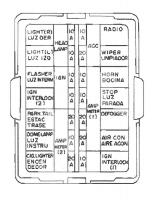Posts posted by sblake01
-
-
-
-
-
-
-
-
-
-
That may help something though I'm not sure what but it won't relieve the fuel pressure.Just note that before you test the equipment-- fuel injection system, you must relieve the fuel pressure by having the vacuum hose disconnected from the fuel pressure regulator and remove the fuel tank cap. Hope this helps. Thanks! -
-
-
-
-
-
Edited by sblake01
I've worked on both types and, actually, the earlier type that would be stock for a 1973 240K would work fine if properly rebuilt. It's basically the same unit used the non North American market early S30 and here beginning with the North American market 1974 260Z through the 1978 280Z. I never noticed much, if any difference between the two performance wise.
-
-
Edited by sblake01
That appears to be a 'mist jet' type compressor. Nissan didn't utilize that type until 1979. A 1973 would have had a 'swash plate' type compressor which would be visually distingushable by the side cover which the one in your video does not have.we recieved the 1973 ( AC ) do u mean a different shape of comp. was thier ? -
-
-
Edited by sblake01
Those look like 280ZX aftermarket 'NACA' ducts (scroll down to part #95-950:
http://www.blackdragonauto.com/icatalog/zr/full.aspx?Page=81
-
-
-
-
Edited by sblake01
I believe that would be the 'Performance Chart' on AC-57. The reason I say that is beacuse I have that page printed out and on the wall above my workbench. It along with the chart for the 810 I used to own weren't in the database I use. Anyway, pressures are only a part of the story, however, and should only be used as a general guideline. That chart also takes humidity and ambient temperature into consideration; factors which are as important if not more so than suction/discharge pressures. I use a charging machine which has a thermometer and a hygrometer on it and I charge by the recommmended system refrigerant weight rather than pressure. When I do put gauges on the system after charging it with the machine, the pressures are within the figures shown on that chart or the chart for the particular vehicle's sytem I'm working on. Using the machine it's 'one and done' while charging with cans or even refrigerant cylinders and gauges can be somewhat trial and error or hit and miss if you don't have a way to factor in temperature and humidity.






Banned from HybridZ? Or.....???
in Open Chit Chat